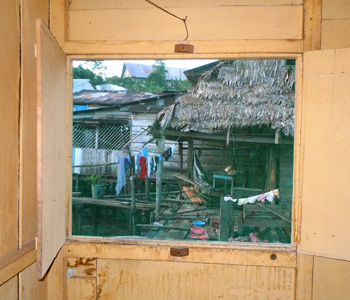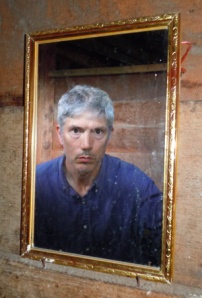New Yagua Crafts, a Monkey-Cat Alliance, and a Gecko in the Toilet
July 18, 2012
July 2, 2012

Map of native communities near the Ampiyacu-Apayacu Regional Conservation Area. Photo by C. Plowden/CACE
While the rain and soccer had delayed our departure from Puca Urquillo by an hour or so, we still had enough time to make a quick stop at the village of Santa Lucia de Pro – the Yagua village immediately upriver from Pebas. Our visit was inspired by reports that this village had some very accomplished artisans. When we climbed up the bank, an informal soccer game was in progress on the cement court on top. Since this was an unanticipated visit, we asked a spectator if the President or other “autoridade” (town officer) was around. The woman dispatched her daughter to fetch the village “secretariat communal” (collective secretary)Iderio Rios. We explained we were interested in meeting the artisans and getting a sense of the range of crafts they made with an eye toward working with them more in the future. Rios responded positively to our request, put out the word, and within ten minutes about ten women artisans had laid out a bag of their crafts on hand on the sidewalk in front of the school.

Wingo masks and chambira bags at Santa Lucia de Pro. Photos by C. Plowden/CACE
Many women apologized that they didn’t have many things in stock, but the impromptu display showed an impressive range of wingo masks and chambira bags with unique designs, llanchama bark “muñecos” (dolls), seed bracelets and necklaces.

Yagua artisan at Santa Lucia del Pro. Photo by C. Plowden/CACE
The artisans said they had most of the dye plants they needed, but their purmas were devoid of chambira palms, so they generally bought cleaned fibers from Brillo Nuevo. Our visit confirmed that artisans here could become enthusiastic partners – both to give them another outlet for selling crafts and possibly to help them reestablish chambira in their own fields. Before doing anything, however, we would prepare a specific proposal and present it to their whole community for consideration.

Yully Rojas inspecting tapetes at San Jose de Piri. Photo by C. Plowden/CACE
We stashed our bags in the hotel right next to the port in Pebas and walked up to San José de Piri, the Yagua community located on the far side of the town. While Yully had started making regular visits there almost a year ago, our progress developing marketable crafts there had been very slow. While this village’ proximity to Pebas arguably gave it easy access to sell its crafts to tourists passing through town, its artisans had not yet tapped this potential market. We went straight to the home of Mariela Ribera who had become Yully’s main contact for a small cadre of women interested in working with us. Three other women arrived and showed us their most recent attempts to make “tapetes” (woven hotpads). The woven coiled chambira looked simple, but it was proving hard to make well. The four samples that women took out of their small plastic bags each had a good element – it had clean white chambira, vibrant color, or was flat. Unfortunately each also had at least one major defect that made it unsellable – it was dirty, had dull color, or was warped. Yully offered her suggestions on how to deal with each of these problems, but we were left with a rather discouraging state of affairs. An earlier attempt to make an attractive doll had not been fruitful, but many months had gone by without the artisans producing anything that we could buy.

Yagua native artisan Mariela with toy chambira hammock. Photo by C. Plowden/CACE
Wandering back into Mariela’s living room, I saw a new kind of craft tacked onto her wall. Artisans throughout the region make and often sell beautiful chambira hammocks. Since these items are so bulky, I didn’t think that we could bring these to the U.S. and market them in a cost-effective way. Mariela, however, had made two hammocks that were only two feet long. Since we were going to try selling some native-made dolls, perhaps there could be a market for hammocks for these or other kinds of dolls. The artisans readily agreed to make somewhat smaller models with three combinations of colors. Clearly it would be easier to develop a product using skills they already have rather than hoping they could master difficult new ones without an experienced teacher.

Mama cat, monkey and kittens. Photo by Yully Rojas/CACE
While I discussed design details for this mini-hammock with Mariela, Yully spotted another example of cross-cultural companionship under her table. Mariela’s cat was nursing a litter of kittens with a saddle-backed tamarin monkey lying cozily on top of her.

View through screen window from Pebas hotel. Photo by C. Plowden/CACE

Campbell in bathroom mirror at Pebas. Photo by C. Plowden/CACE
Back at our hotel, I admired the view from my room and cleaned up for the first time in a few days by pouring buckets of cold water over my head from a barrel in the bathroom. I also got my first look in a mirror in over a week, but didn’t have a razor up to the task of shaving my itchy incipient beard.

Catfish in market & gecko in toilet in Pebas hotel. Photos by C. Plowden/CACE
Other glimpses of local wildlife around Pebas included a gecko in a disconnected toilet in the hotel’s storage area and catfish in the market that were so fresh they were still croaking.
Our trip back to Iquitos was slow but peaceful. There were no camarotes (cabins) available on the lancha (ferry), so Yully and I strung our hammocks side by side on the less crowded top deck. I had hoped to get some writing done on the way, but was reluctant to bring my computer out in the open and I couldn’t quite figure out anyway how to hold and type on my laptop while lying in a hammock. I was content to immerse myself in podcasts from National Public Radio that my wife had downloaded onto my MP3 player about six months before. Listening to Car Talk, This American Life, Science Friday and Freakonomics seemed a bit surreal cruising by miles of forests and towns where the topics discussed were irrelevant. Listening to Click and Clack humor and soothing intelligence of Diane Rehm and other NPR hosts, however, was a comforting and stimulating way to pass a day on the river.
My only live diversion on the 20 hour trip was a few conversations with a Haitian fellow I met brushing my teeth. I’m not certain about his story since we communicated with a mixture of poorly spoken or understood French, Spanish and English. What I pieced together is that he and two friends had left their impoverished country about four months ago in search of work. They had spent a few months in Ecuador, one month in Peru and had taken this boat downriver to try their luck in Brazil. They were turned back at the border, though, for lack of a visa. Their return to Peru, however, was not proceeding smoothly. He pointed to a Peruvian soldier in a hammock about fifteen feet away who would escort them to immigration authorities when they got to Iquitos. I gave him some of my bananas for breakfast and wished him well.


Leave a comment
Comments will be approved before showing up.




